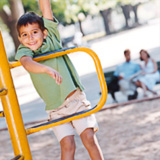Diagnosis and Managing Attention Deficit Hyperactivity Disorder (ADHD) in Children
 Everyone – child, teen and adult – has times when they have trouble focusing, are disorganized, or feel fidgety. For most of us, those issues are temporary and relatively harmless. However, for kids with attention deficit hyperactivity disorder, or ADHD, problems with hyperactivity, distractibility and impulsivity are persistent and impairing. If your child has ongoing patterns of difficulty paying attention, being overactive, or acting without thinking that significantly interfere with home or school life, the experts at University Hospitals Rainbow Babies & Children’s Hospital's Division of Developmental and Behavioral Pediatrics and Psychology are here to help.
Everyone – child, teen and adult – has times when they have trouble focusing, are disorganized, or feel fidgety. For most of us, those issues are temporary and relatively harmless. However, for kids with attention deficit hyperactivity disorder, or ADHD, problems with hyperactivity, distractibility and impulsivity are persistent and impairing. If your child has ongoing patterns of difficulty paying attention, being overactive, or acting without thinking that significantly interfere with home or school life, the experts at University Hospitals Rainbow Babies & Children’s Hospital's Division of Developmental and Behavioral Pediatrics and Psychology are here to help.
What is ADHD?
ADHD is a brain-based biological disorder and the most commonly diagnosed behavior disorder of childhood. Symptoms may be present from a very young age, but most families seek help when their children are old enough for symptoms to interfere with learning and social adjustment in school. While the precise cause of ADHD is unknown, evidence indicates that it is caused by a combination of genetic and environmental factors.
There are three primary types of ADHD:
- ADHD combined type. This is the most common type of ADHD, characterized by both impulsive and hyperactive behaviors as well as inattention and distractibility. Boys are more likely than girls to experience ADHD with hyperactive symptoms.
- ADHD, inattentive and distractible type. This type of ADHD is characterized by inattention and distractibility without hyperactivity. Girls with ADHD are more likely to have this version, rather than hyperactivity.
- ADHD, impulsivity/hyperactive type. Children with this least common type of ADHD demonstrate impulsive and hyperactive behaviors without inattention and distractibility.
How is ADHD diagnosed?
In UH Rainbow Babies & Children's Hospital's Division of Developmental and Behavioral Pediatrics, experts in developmental behavioral pediatrics, pediatric neuropsychology, and pediatric psychology will work with your family to help you understand the causes of your child's concerning behaviors. We will obtain a detailed history of your child's behavior from you and your child's teachers, observe your child's behaviors under varied circumstances, and conduct physical, neurological, and psychological testing to determine if your child has ADHD. Your appointment will also include assessment for other conditions that commonly co-occur with ADHD, such as learning disabilities, anxiety disorder, conduct disorder or depression.
What is the treatment for ADHD?
While there is no cure for ADHD, currently available treatments can help reduce symptoms and improve your child’s functioning. Treatments include medication, psychotherapy, behavioral interventions, or a combination of treatments.
The Division of Developmental and Behavioral Pediatrics will work with you to find the treatments that work best for your child and help him or her manage the symptoms that get in the way of functioning or development.
For many children and teens, ADHD medications reduce hyperactivity and impulsivity and improve their ability to focus, work and learn. Behavioral therapies can help children and families better cope with daily challenges and help kids and teens stay organized and follow directions. We can work with parents to give you the tools to better manage your child's disruptive or negative behaviors and reinforce positive behaviors. Your Rainbow specialist can also work with your child's school to help children succeed in the classroom.


